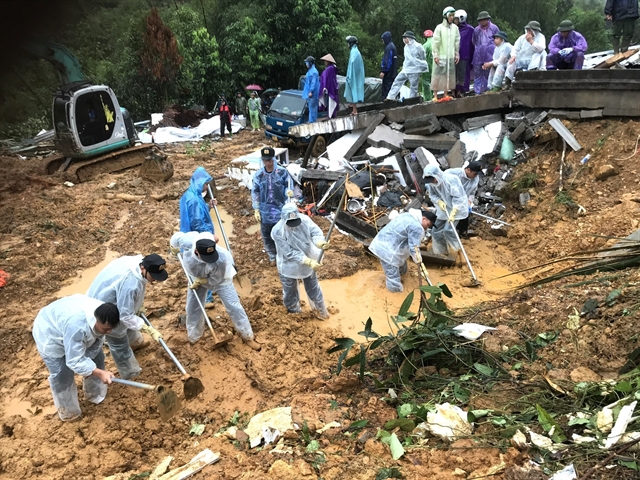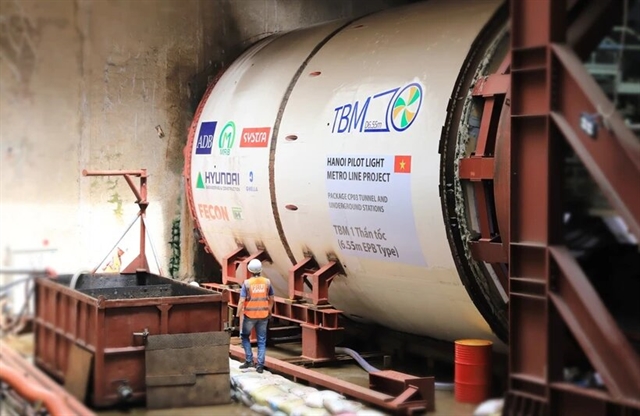Over 232 disaster events were recorded nationwide, including storms, floods and landslides. Among these, Typhoon Yagi stood out as the most destructive.
 |
Officers and soldiers from the Hà Giang Province Police search for missing victims following a severe landslide caused by Typhoon Yagi along National Highway No 2. — VNA/VNS Photo |
HÀ NỘI — The natural disasters of 2024 were devastating and extreme, leaving 514 people dead or missing and causing estimated economic losses of over VNĐ88.748 trillion (US$3.48 billion).
This catastrophic year highlighted the increasing severity of natural calamities in Việt Nam and underscored the urgent need for improved disaster preparedness and mitigation strategies.
Hoàng Phúc Lâm, deputy director of the National Centre for Hydro-Meteorological Forecasting, said that as of December 25, there were ten storms and one tropical depression in the East Sea, two fewer than the annual average.
Despite this lower number, the intensity and impact of these storms were staggering.
Four storms directly impacted Việt Nam, with storm No. 3 (Typhoon Yagi) being the strongest in the past 30 years.
Typhoon Yagi wreaked havoc across Quảng Ninh and Hải Phòng with winds of levels 10-12, gusting to levels 13-15.
These gale-force winds caused widespread destruction, particularly in the northeastern provinces and Hà Nội, where infrastructure, homes, and public services suffered extensive damage.
From September 6 to 12, heavy rains triggered by storm No. 3 inundated the northern region, with rainfall exceeding four to six times the annual average. Major rivers such as Thao, Lô, and Thái Bình rivers overflowed, surpassing danger levels and causing devastating floods.
Thousands of hectares of agricultural land were submerged and transportation networks paralysed, further complicating rescue and relief efforts.
The mountainous and midland areas faced the dual threat of landslides and flash floods. These natural phenomena obliterated entire villages, displaced thousands, and caused an untold loss of human lives and properties.
Beyond the storms, 2024 witnessed an alarming increase in extreme weather events. A total of 39 flash floods and landslides occurred across 32 provinces, with the northern and central regions bearing the brunt of the damage.
Provinces like Hà Giang, Lào Cai, Yên Bái and Cao Bằng were the most severely affected.
Adding to this, Việt Nam endured 18 cold spells and 19 heatwaves, a stark reminder of the unpredictability of climate change.
The Central Highlands and central regions suffered from acute water shortages, disrupting agricultural production and exacerbating socio-economic challenges.
Meanwhile, the Mekong Delta, a vital agricultural hub, faced an early onset of saltwater intrusion, threatening the livelihoods of millions dependent on rice farming and aquaculture.
Urban areas were not spared either.
Intense thunderstorms, accompanied by heavy rains, overwhelmed drainage systems in major cities, leading to severe flooding and widespread disruption of daily life.
Deputy Minister of Agriculture and Rural Development Nguyễn Hoàng Hiệp described the natural disasters of 2024 as unprecedented in extremity and frequency.
 |
A devastating flash flood struck Nủ Village, Phúc Khánh Commune, Bảo Yên District in Lào Cai Province, on the night of September 11, leaving 24 dead and 70 missing. — VNA/VNS Photo |
Over 232 disaster events were recorded nationwide, including storms, floods, and landslides. Among these, Typhoon Yagi stood out as the most destructive.
The aftermath of Yagi was catastrophic: 345 fatalities or missing persons were reported, while agricultural production and infrastructure were devastated.
Roads, schools, and healthcare facilities were severely damaged, disrupting essential services for months.
The economic losses from this single storm alone reached VNĐ81.7 trillion ($3.2 billion), a record figure highlighting the scale of destruction.
In response, the Ministry of Agriculture and Rural Development coordinated with local authorities to address over 800 dyke-related incidents.
Despite these efforts, critical infrastructure remained vulnerable.
Emergency response teams worked tirelessly to evacuate affected populations, deliver relief supplies and repair damaged infrastructure.
However, these efforts were often hampered by the lack of adequate resources.
Nguyễn Văn Tiến, deputy director of the ministry's Department of Dyke Management and Disaster Prevention, noted that 2024 was the hottest year in global history.
Việt Nam experienced 21 of the 22 recognised types of natural disasters, ranging from severe droughts in the southern provinces to catastrophic floods and landslides in the northern and central regions.
The disasters emphasised the importance of integrating disaster risk reduction into socio-economic planning.
Efforts were underway to implement international commitments, such as the Sendai Framework for Disaster Risk Reduction, and to strengthen ASEAN cooperation on disaster management.
Tiến said that by shifting focus from response to early action, the Government aimed to minimise damage, save lives, and protect livelihoods. — VNS



